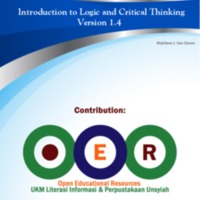Introduction to Logic and Critical Thinking Version 1.4
Dublin Core
Description
This is an introductory textbook in logic and critical thinking. The goal of the
textbook is to provide the reader with a set of tools and skills that will enable
them to identify and evaluate arguments. The book is intended for an
introductory course that covers both formal and informal logic. As such, it is not
a formal logic textbook, but is closer to what one would find marketed as a
“critical thinking textbook.” The formal logic in chapter 2 is intended to give an elementary introduction to formal logic. Specifically, chapter 2 introduces several different formal methods for determining whether an argument is valid or invalid (truth tables, proofs, Venn diagrams). I contrast these formal methods with the informal method of determining validity introduced in chapter 1. What I take to be the central theoretical lesson with respect to the formal logic is simply that of understanding the difference between formal and informal methods of evaluating an argument’s validity. I believe there are also practical benefits of learning the formal logic. First and foremost, once one has internalized some of the valid forms of argument, it is easy to impose these structures on arguments one encounters. The ability to do this can be of use in evaluating an argumentative passage, especially when the argument concerns a topic with which one is not very familiar (such as on the GRE or LSAT).
textbook is to provide the reader with a set of tools and skills that will enable
them to identify and evaluate arguments. The book is intended for an
introductory course that covers both formal and informal logic. As such, it is not
a formal logic textbook, but is closer to what one would find marketed as a
“critical thinking textbook.” The formal logic in chapter 2 is intended to give an elementary introduction to formal logic. Specifically, chapter 2 introduces several different formal methods for determining whether an argument is valid or invalid (truth tables, proofs, Venn diagrams). I contrast these formal methods with the informal method of determining validity introduced in chapter 1. What I take to be the central theoretical lesson with respect to the formal logic is simply that of understanding the difference between formal and informal methods of evaluating an argument’s validity. I believe there are also practical benefits of learning the formal logic. First and foremost, once one has internalized some of the valid forms of argument, it is easy to impose these structures on arguments one encounters. The ability to do this can be of use in evaluating an argumentative passage, especially when the argument concerns a topic with which one is not very familiar (such as on the GRE or LSAT).
Creator
Source
25. rkbctcWjo3OFhGODNSYTZPMVU/view
Publisher
Contributor
Rahmah Agustira
Rights
Creative Commons
Type
Files
Collection
Citation
Matthew J. Van Cleave , “Introduction to Logic and Critical Thinking Version 1.4
,” Open Educational Resources (OER) , accessed November 15, 2025, https://oer.uinsyahada.ac.id/items/show/280.


